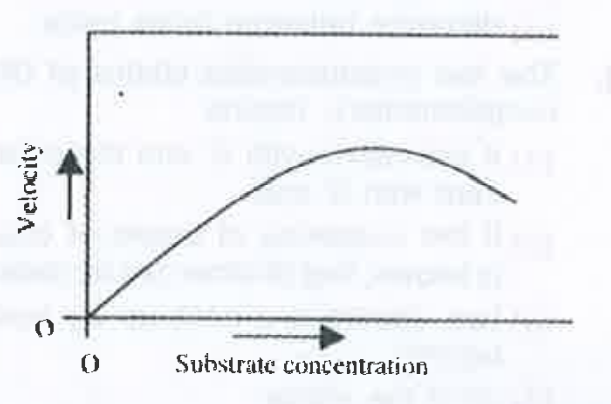Substrate that show E1 reaction
CH3CH2I

CH3−CH3∣C∣CH3−CH2−I

The correct Answer is:C
To determine which substrate shows an E1 reaction, we need to identify the stability of the carbocation formed during the reaction. E1 reactions involve the formation of a carbocation intermediate, and the stability of this carbocation is crucial for the reaction to proceed.
1. Understanding E1 Mechanism:
- E1 stands for unimolecular elimination. It involves two steps: the formation of a carbocation intermediate and the elimination of a leaving group to form a double bond.
2. Identify the Stability of Carbocations:
- Carbocation stability increases in the following order: primary < secondary < tertiary. Therefore, substrates that can form tertiary carbocations are more likely to undergo E1 reactions.
3. Analyzing the Options:
- Option 1: This substrate will lead to the formation of a primary carbocation. (Not favored for E1)
- Option 2: This substrate will also lead to a primary carbocation. (Not favored for E1)
- Option 3: This substrate will again lead to the formation of a primary carbocation. (Not favored for E1)
- Option 4: This substrate will lead to the formation of a tertiary carbocation after the leaving group departs. (Favored for E1)
4. Conclusion:
- Among the given options, the substrate in Option 4 is the one that will show an E1 reaction because it forms the most stable carbocation (tertiary).
Final Answer:
The substrate that shows E1 reaction is Option 4.
---
- E1 stands for unimolecular elimination. It involves two steps: the formation of a carbocation intermediate and the elimination of a leaving group to form a double bond.
- Carbocation stability increases in the following order: primary < secondary < tertiary. Therefore, substrates that can form tertiary carbocations are more likely to undergo E1 reactions.
- Option 1: This substrate will lead to the formation of a primary carbocation. (Not favored for E1)
- Option 2: This substrate will also lead to a primary carbocation. (Not favored for E1)
- Option 3: This substrate will again lead to the formation of a primary carbocation. (Not favored for E1)
- Option 4: This substrate will lead to the formation of a tertiary carbocation after the leaving group departs. (Favored for E1)
- Among the given options, the substrate in Option 4 is the one that will show an E1 reaction because it forms the most stable carbocation (tertiary).
The substrate that shows E1 reaction is Option 4.
Topper's Solved these Questions
- ORGANIC REACTION MECHANISMS-IVBOOK - RESONANCE ENGLISHCHAPTER - ORGANIC REACTION MECHANISMS-IVEXERCISE - APSP PART-2
17 Videos
- ORGANIC REACTION MECHANISMS-IVBOOK - RESONANCE ENGLISHCHAPTER - ORGANIC REACTION MECHANISMS-IVEXERCISE - APSP PART-3
22 Videos
- ORGANIC REACTION MECHANISMS-IVBOOK - RESONANCE ENGLISHCHAPTER - ORGANIC REACTION MECHANISMS-IVEXERCISE - Exercise-3 Part-2 JEE (MAIN ) ONLINE PROBLEMS
10 Videos
- ORGANIC REACTION MECHANISMS - IIBOOK - RESONANCE ENGLISHCHAPTER - ORGANIC REACTION MECHANISMS - IIEXERCISE - APSP Part - 3
22 Videos
- PERIODIC TABLE & PERIODICITYBOOK - RESONANCE ENGLISHCHAPTER - PERIODIC TABLE & PERIODICITYEXERCISE - ORGANIC CHEMISTRY(BASIC CONCEPTS)
27 Videos
Similar Questions
Knowledge Check
Refer to the given graph showing relationship between temperature and enzyme action.
Select the correct statement regarding 'A' and 'B'.
(i) 'A' shows the rate at which reaction decreases due to denaturation of enzyme molecules.
(ii) 'B' shows rate at which reaction increases due to decreased kinetic energy of substrate.
(iii) As temperature rises, more and more enzyme molecules are denatured and 'A' appears to fall.
(iv) 'B' shows rate at which reaction increases due to increased kinetic energy of substrate and enzyme molecules.
 A(i),(iii) and (iv)B(iii) onlyC(iii) and (iv) onlyD(i) and (ii) only
A(i),(iii) and (iv)B(iii) onlyC(iii) and (iv) onlyD(i) and (ii) only
Substrate level phosphorylation does not occur in which of the following reaction of aerobic respiration ?
View SolutionIn which of the following substrates, rate of Benzoin substrates, rate of condensation will be maximum ?
View SolutionFor which substrate RuBisCO shows greater affinity?
View SolutionCorrect statement for E1 Reaction is :
View SolutionDuring an enzyme catalyze reaction , the substrate reaches a transition stage Which is
View SolutionThe substrate for photorespiration is
View SolutionThe substrate of photorespiration is
View Solution

